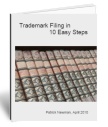This is the second in a series of trademark filing basics. 
Must I hire an attorney
No. However, if you prepare and submit your own application, you must comply with all requirements of the trademark statute and rules. If you choose to appoint an attorney to represent your interests before the USPTO, they will correspond only with your attorney.
What must the application include?
An trademark filing must include the following elements before the USPTO will accept it:
- the name of the applicant;
- a name and address for correspondence;
- a clear drawing of the mark;
- a listing of the goods or services; and
- the filing fee for at least one class of goods or services.
If your application does not meet these requirements, the USPTO will return the application papers and refund any fees submitted.
If you file a paper application, and it meets the minimum filing requirements, the USPTO will assign a serial number and send a filing receipt. You should review this receipt for accuracy, and notify the USPTO of any errors, following the directions on the receipt.
An electronically-filed application must include the same information to receive a filing date. However, at the time of filing, an e-mail summary, including a serial number, is sent. No paper filing receipt is generated. If through later review the USPTO determines that the application did not include the required information, they will cancel the serial number and filing date, return the application, and refund the filing fee.
If you transmit your application over the Internet, the filing date is the date the transmission reaches the USPTO server. Otherwise, the filing date of an application is the date the USPTO receives the application.
NOTE: Receiving a trademark filing date does not mean that you have satisfied ALL registration requirements. To obtain a registration, you must comply with all application requirements, and overcome any refusal(s) issued by the examining attorney during examination.
Although only the minimum trademark filing requirements must appear in your initial application to receive a filing date, submitting all available information requested in the application form will help reduce delays in processing your application. See below for more information about these requirements.
Name of the Applicant
The application must be filed in the name of the owner of the mark. The owner of the mark is the person or entity who controls the nature and quality of the goods identified by the mark and/or the services rendered in connection with the mark. The owner may be an individual, corporation, partnership, or other type of legal entity.
Do you have to be a U.S. citizen to apply?
No. However, if you do not reside in the United States, you may appoint a “domestic representative” as part of the application process (see below).
Name and Address for correspondence
The name and address for correspondence is the address where the USPTO will send communications concerning the application. It may be that of the applicant or the applicant’s legal representative. Also, an applicant residing outside the United States may list a domestic representative, that is, the name and address of any person residing in the U.S. “upon whom notices or process may be served for proceedings affecting the mark.”
You must keep your mailing address up-to-date with the USPTO. This can be done through the USPTO’s (Trademark Electronic Application System) TEAS at http://www.uspto. gov/teas/index.html . If you send a notice of change of address on paper, please include at the top of the request a “heading” listing the applicant’s name, mark, and the application serial number. Mail the change of address to:
Commissioner for Trademarks
P.O. Box 1451 Alexandria , VA 22313-1451
Depiction of the Mark (“the drawing’)
Every application must include a clear drawing of the mark you want to register. We use the drawing to file the mark in the USPTO search records and to print the mark in the Official Gazette and on the registration certificate.
USPTO’s TEAS (Trademark Electronic Application System) generates a proper drawing for you, based on the information you enter. . If you are preparing the drawing page yourself, use white, non-shiny paper that is 8½ inches wide by 11 inches long (21.59 cm by 27.94 cm). The mark can be no larger than 3.5 inches high by 3.5 inches wide (8 cm by 8 cm). The drawing page should include a “heading” with the following elements:
- applicant’s name;
- correspondence address;
- listing of goods and/or services; and
- dates of use (if already using the mark in commerce); or, wording “Intent to Use.”
The representation of the mark must then appear below the heading, in the middle of the page, in the proper format for either a “standard character” drawing or a “stylized or special form” drawing (see below). Important: Once filed, you cannot make a material change to your mark.
Depiction of the Mark (as a drawing) in more detail.
There are two (2) types of depiction of the Mark as a Drawing:
- Standard Character
- Stylised or Special Form drawing
Standard Character
You may submit a standard character drawing if:
- All letters and words in the mark are depicted in Latin characters;
- All numerals in the mark are depicted in Roman or Arabic numerals;
- The mark includes only common punctuation or diacritical marks; and
- The mark does not include a design element.
You must also submit the following statement:
“The mark is presented in standard character format without claim to any particular font style, size or color.”
You may depict the mark in any font style; may use bold or italicized letters; and may use both uppercase and lowercase letters, all uppercase letters or all lowercase letters.
The USPTO has created a standard character set that lists letters, numerals, punctuation marks, and diacritical marks that may be used in a standard character drawing, available on the USPTO’s website at http://teas.uspto.gov/ standardCharacterSet.html. If you want to register characters that are not in the set, then you must file a special form drawing.
Stylised or Special Form drawing
If the particular style of lettering is important or the mark includes color or a design or logo, you must select the “stylized or special form” drawing format. The drawing page should show a black and white image of the mark unless color is claimed as a feature of the mark, no larger than 3.5 inches by 3.5 inches (8 cm by 8 cm). The drawing in special form must be a substantially exact representation of the mark as it appears on the specimen or on the foreign registration, as appropriate.
Colour
If colour is important then you can depict color in your application.
You must submit a color drawing and;
- a color claim naming the colors that are a feature of the mark; and
- a separate statement describing where the color(s) appear on the mark.
You need to pay attention to details like color and description of your mark before you do the actual trademark filing,
 The Australian Governments trade promotion agency Austrade (http://www.austrade.gov.au) has been forced to find brand new logo.
The Australian Governments trade promotion agency Austrade (http://www.austrade.gov.au) has been forced to find brand new logo. 





